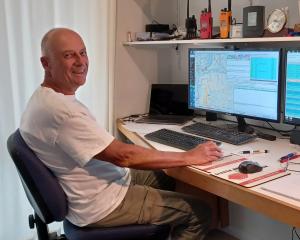
In a decision released yesterday hearings commissioner Bob Nixon concluded Contact Energy’s application for a 0.65 ha two-lot subdivision, and land use consent for the construction of a data centre and associated facilities at 46 Fruitgrowers Rd, Earnscleugh, be approved.
The approval comes subject to standard regulatory and building conditions regarding subdivision, services and land use.
The decision will do little to appease critics who have questioned what the data centre will be used for, saying it will be of no benefit to Central Otago — or even wider New Zealand.
In his decision, Mr Nixon summarised the evidence presented at a hearing on February 18.
In his evidence, Landpro planner Matt Curran said the proposal consisted of the construction of eight containerised data centres, associated facilities and a noise mitigation wall along the eastern and southern boundaries of the site.
The containers would each hold 368 servers.
The proposal also included vehicle access, five car parks, loading, and manoeuvring space and landscaping and planting around the perimeter.
At the time the application was lodged, a notice of requirement was issued by Aurora Energy for a substation beside the data centre to provide it with a direct connection to the local distribution network and for a new supply for Clyde from 2025.
The data centre would be operated by a separate entity, Lake Parime, under a lease agreement with Contact.
Lake Parime is a privately owned UK digital infrastructure company connected to renewable energy sources for machine learning, modelling, data visualisations, with a particular focus on block chain and cryptocurrency mining.
No staff would be permanently based on the site but Lake Parime would employ a small number of specialised maintenance staff to manage the servers within the data centre.
Contact Energy head of hydro generation Boyd Brinsdon said in evidence the reason the site was selected was because it was next to the Clyde power station reducing transmission and distribution losses.
In 2018, data centres internationally consumed about 1% of globally generated electricity, and this demand was expected to substantially increase in the next decade.
New Zealand was attractive due to its high proportion of renewable electricity generation.
He explained Lake Parime was entering into a commercial relationship with Contact Energy for the supply of up to 10MW of electricity.
The data centre could operate when electricity demand was low, and scale back its operations and use of electricity when demand was high. Data processing was not part of Contact Energy’s core business, but it would continue to hold the resource consents in its own name as applicant to ensure the data centre operated within the environmental parameters required by its resource consents, Mr Brinsdon said.
Three submissions opposing the application due to concerns about noise were considered by Mr Nixon but none of the submitters spoke at February’s hearing.
Comments
"The decision will do little to appease critics who have questioned what the data centre will be used for, saying it will be of no benefit to Central Otago - or even wider New Zealand."
And :
"In 2018, data centres internationally consumed about 1% of globally generated electricity, and this demand was expected to substantially increase in the next decade.
New Zealand was attractive due to its high proportion of renewable electricity generation."
OUR NZ Clyde Dam, built at an eye-watering (ongoing !) cost. Gifted to data crypto currency miners. Disgusting !
Why are we not using that clean RENEWABLE power in Central Otago for something of value to us? If not Otago as well? For shame, Contact and associated enablers.
There are risks to this "industry." "The risks of mining are often financial and regulatory... Bitcoin mining, and mining in general, is a financial risk because one could go through all the effort of purchasing hundreds or thousands of dollars worth of mining equipment only to have no return on their investment. That said, this risk can be mitigated by joining mining pools. If you are considering mining and live in an area where it is prohibited, you should reconsider. It may also be a good idea to research your country's regulation and overall sentiment toward cryptocurrency before investing in mining equipment.
"One additional potential risk from the growth of Bitcoin mining (and other PoW systems as well) is the increasing energy usage required by the computer systems running the mining algorithms. Though microchip efficiency has increased dramatically for ASIC chips, the growth of the network itself is outpacing technological progress. As a result, there are concerns about Bitcoin mining's environmental impact and carbon footprint." Ref 'What Is Bitcoin Mining?' https://www.investopedia.com/tech/how-does-bitcoin-mining-work/#:~:text=...
Contact Energy Shares have been an excellent long term investment.Might buy some more.Allowing productive farms to be planted in pine trees to allow an offshore company to offset its carbon emissions doesn't do much for NZ either.













